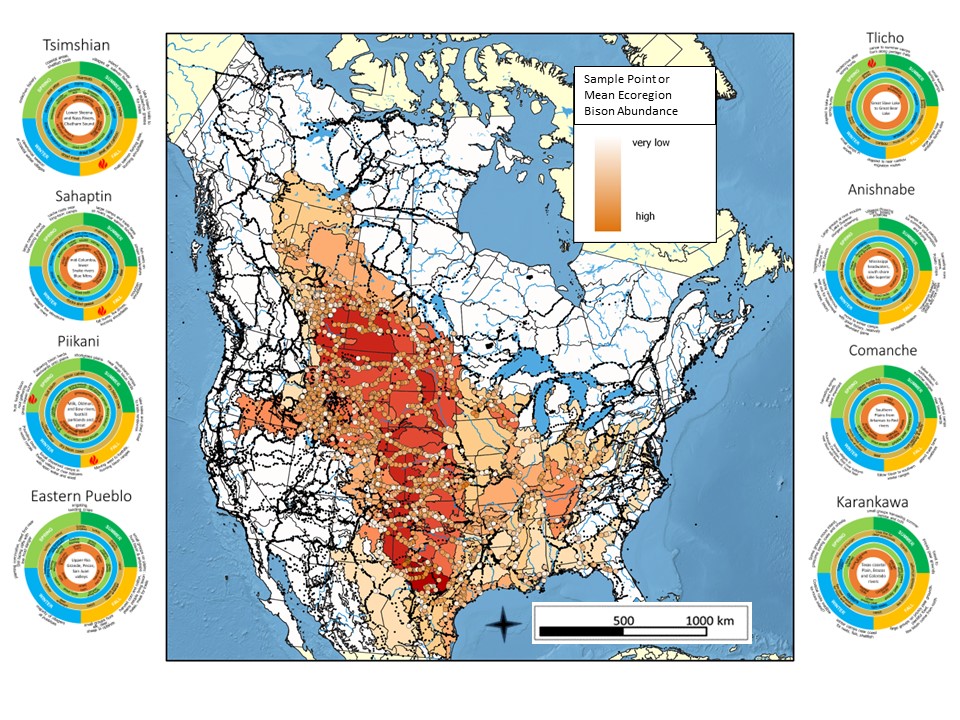Report Summary
For >15K years since humans entered North America, they have jointly occupied the continent with “The Buffalo” – an evolving lineage of species of the genus Bison, the largest mammal surviving the early Holocene continental extinction event. Eventually Bison bison, the subspecies with a distribution centered on the Great Plains, persisted in the presence of people. At the time of European contact, buffalo numbered in the millions, occupying not just the plains, but adjacent areas in the western Cordillera, the northern taiga, and eastern woodlands. Moreover, archaeological and paleontological information indicates that although bison’s distribution and abundance has varied over millennium, in general the species has maintained a relatively stable distribution in the center of the continent. Ecologists describe that a combination of biophysical (bottom-up forage production) and cultural (top-down predation) factors determined bison distribution and abundance. At a continental scale a simple bottom-up/top-down interaction fails to describe the feedback mechanisms necessary for bison population regulation and stability. A more complex hypothesis also recognizes the importance of surface water availability in core bison habitat in the center of the Great Plains:
Humans, beaver and the buffalo are long-term mutualists. Humans, through fire use and conserving beaver contributed additions to the essentials of bison habitat—forage, water and winter cover. More importantly, by regulating bison populations with predation, humans kept the bison from degrading habitats. In return, the buffalo could provide many humans with nearly everything—food, clothing, shelter and for some cultures, a complete circle of life.
The evaluation of this hypothesis proceeds by first describing applicable niche construction, optimal foraging, seasonal rounds and foraging, and mutualism theory. This is then used to develop a preliminary conceptual model for bison distribution and abundance influenced by biophysical, cultural and mutualistic factors. The model is evaluated using fire history evidence from ~150 studies across the continent, food resource abundance data from ~30,000 days of first-person journal observations from early European travellers’ crossings of ~140 ecoregions, and current ecological data on the effects of bison and other large herbivores in select areas. This data was evaluated with three analyses: 1) spatial evaluation of fire frequency, biophysical variables and resource abundance indices across ecoregions during the European contact period, 2) temporal evaluation of how bison and human abundance varied in select regions during the immediate pre-contact and early contact periods, and 3) utilizing current data to estimate historic bison densities and fire regimes that would maintain the pre-contact condition riparian zones as visible in historic photographs.
At a continental level, a multivariate random forest analysis of biophysical and cultural data showed bison abundance was best predicted by ecoregions with high grassland cover, followed by fire frequency (almost always Indigenous ignitions), deciduous forest cover (providing habitat for humans on the edge of grasslands), alternate resources available to humans (plants, fish, fowl, other sources meat), and human abundance. Bison showed a consistent pattern of expanding into various regions after human depopulation events ~ CE 1200 to 1800. At regional scales, the pattern of bison abundance and distribution varied. Although decreasing grassland cover and increasing human abundance was always correlated with bison population declines and range edges, the alternate resources used by humans varied. In the SW plants (corn resources used by Pueblos) were the primary alternate resource, in the NW fish (salmon bearing streams), in the NNW a combination of fish and other prey (caribou and moose), in the NNE wild rice, and in the NE and SE a range of domestic and wild plants.
Historical photographs and journal accounts consistently document vigorous riparian zones, aspen communities, and beaver abundance. The mean historic bison resource abundance index for ecoregions was calibrated using modern analogs for stocking densities to develop a range of likely historic bison densities that would maintain these conditions. This method predicts 8 ecoregions in the core of the Great Plains with high bison abundance (> 3 bison/km2), 18 ecoregions with moderate bison abundance (1 to 3 bison/km2), 44 ecoregions with low abundance (< 1 bison/km2), with a further >60 ecoregions with no bison observed. Extrapolating by the area of ecoregions, and periods when bison range expanded for various ecoregions, this method predicts a total continental bison population of approximately 5 to 10M bison at ~ CE 1200, increasing to 12 to 25M bison at ~CE 1700 to 1800 due to Indigenous depopulations followed by increases in bison’s distribution and abundance. These estimates are supported by other researchers using other methodologies.
The analysis concludes that a long-term human-bison-beaver mutualistic relationship provides a reasonable explanation for the historical spatial and temporal variation in bison at a continental level, and long-term habitat conditions. Human’s primary role in the mutualism was in hunting bison to densities of <1/km2 in most ecoregions and possibly stimulating bison behavioral avoidance of riparian zones and other risky terrain. Low bison densities maintained beaver habitat which in turn provided water for both humans and bison, woodlands important for humans, and herbaceous and woody fuels for fire. Successful restoration of bison requires human predation to maintain habitat for both beaver and bison, and many ecological communities.
Data Sources:
-Ecoregions visible online at: https://ecoregions.appspot.com/
-Wildlife and plant resources observed in historical journals currently at: https://lensoftimenorthwest.com/themes/lens-northwest-files/google-earth-map-journal-wildlife-observations/
-After c. 2026, back-up digital databases and a copy of this report will be archived with various global biodiversity data centers (hopefully) and at very least, at the Whyte Museum Archives, Banff, Alberta Clifford A. White fonds: https://www.whyte.org/digitalvault/categories/archives-library
Suggested Citation: White, Clifford A. 2025. “Buffalo Continent: Historical Distribution and Abundance of North American Bison.” Historical Ecology of Bison and Humans, North America Progress Report 2025-05-25 version. CW and Associates, Canmore, AB.
